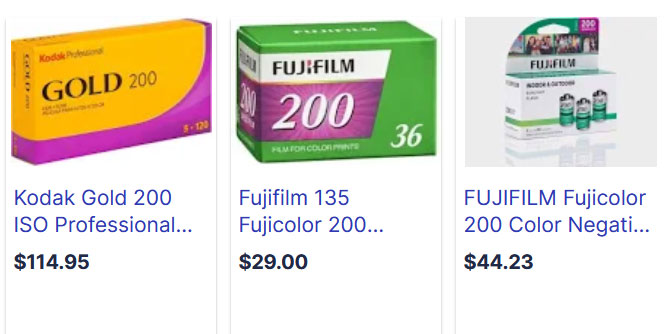Kodak Alaris and Fujifilm continue to blatantly rip off their film photography customers, with both companies pushing up already extortionate prices on a regular basis.

Jut this month Kodak Alaris announced its latest price increase, of up to 40 percent, to bite in March. This follows hard on the heels of Fujifilm’s announcement last October that it was upping prices of both film and Fujifim Crystal Archive paper by 15 percent – about 6 months after its last film price hike.
Amazon’s photo enthusiast website, DPReview, notes in a recent article that Kodak Portra film is now triple the cost is was in 2018. A single roll of Kodak Gold 300 in Australia – when it is available – ranges anywhere from $18 to $31. Fujifilm 200 will set you back $25 – 30.
Kodak Alaris and Fujifilm will bleat about increased cost of raw materials, energy, transportation and logistics, but the truth is that their profit margins on film are now massive, easily able to absorb these costs. And after a Covid-induced spike, transport and logistic costs have actually fallen significantly in the last six months. You won’t see concomitant reductions in film prices, though.
And in the various price increase announcements we’ve seen over the last few years, both falling demand and rising demand have been cited as reasons for price rises. Cute.
Most galling of all are the gaslighting statements of care and concern which inevitably accompany these price rise announcements. In short, both companies are oh so aware of the importance of photography in all our lives and their profound heritage in photographic technology and their pride in sustaining that heritage, etc, etc.
The reality contained in a careful reading of their financial reports is that film is a profit-making sector of both the Kodak Alaris and Fujifilm businesses. Which would be a good thing for the future of silver halide film, ordinarily.
The problem for customers is that film is not a part of Fujifim’s plans for its future – or only insofar that the cash generated bankrolls areas for growth, like its health business. Kodak Alaris is merely a brand licensee, not a manufacturer, whose future as a ‘going concern’ is annually debated by its own auditors. The crushing debts cannily flick-passed to it by Eastman Kodak when it emerged from bankruptcy in 2013 have been a millstone which only gets heavier year on year.
So with Fujifilm not interested in the future of film or its film customers, and Kodak Alaris basically a ticket-clipping middleman between the film manufacturer – Eastman Kodak – and the customer, can colour film photography survive? The answer, I believe, lies with Old Yella.
Unlike Fujifilm, Eastman Kodak seems genuinely interested in growing its still film business. While there has been a steady reduction of the Fujfilm range along with swingeing price increases over the last five years, Eastman Kodak has re-introduced Ektachrome 100 and more recently Kodak Gold 200 in 120 format. It is also, apparently, manufacturing Fujfilm 200.
It has also started to hire more staff for its still film lines and increased production. In a podcast at the end of last year, Nagraj Bokinkere, Eastman Kodak’s vice-president of film manufacturing, made a call out for more workers on its film manufacturing lines:
‘Consumer demand, particularly for 35mm film, has exploded over the last few years,’ he said.
‘Our retailers are constantly telling us they can’t keep these films on the shelves and they want more. So, really our strategy of being the last company standing in colour films, the last company making colour films in both consumer and motion picture, is paying dividends.
We literally cannot keep up with demand, we need more employees. We’re hiring,’ said Bokinkere.
He said film finishing is now running as a 24/7, three-shift operation, with 300 new hires in the 18 months to October last year.
But to really be the ‘last company standing’ in colour film, Eastman Kodak needs to have control of retail pricing. Kodak Alaris, desperate to generate cash, and Fujifilm, because film is not part of its future, will eventually kill the silver goose. Every time prices rise, a few more analog photographers fall by the wayside.
If Eastman Kodak can work out a way to take back the licence to use the Kodak logo on film – currently an asset of Kodak Alaris – it will have a vested interest in leading an orderly market where the manufacturer/distributor makes a decent profit and the film enthusiasts aren’t being cynically exploited, as is the case at the moment.
Why you may even have a scenario where Eastman Kodak manufactures all film for both Kodak and Fujifilm. Sony manufacturers the ‘digital film’ (image sensors) for a range of its competitors – why shouldn’t Eastman Kodak do likewise for analogue?
– Keith Shipton





Keith, your analysis is spot on. Already I think we are seeing a slow down in demand for 35mm film. Once upon a time we couldn’t get enough second hand 35mm point& shoot and SLR cameras to meet demand. Now they sit our shelves for weeks. The price of film is yet to be a driver in this slow down, but the upcoming prices increases will certainly have an impact.